Case Study Analysis: Wal-Mart's Strategies for Competitive Advantage
VerifiedAdded on 2023/01/23
|27
|6307
|27
Case Study
AI Summary
This case study analyzes Wal-Mart's business operations, focusing on its cost leadership strategy and competitive advantages. The study identifies key issues, such as maintaining cost leadership with good quality products and services, and employs strategic tools like Porter's Generic Strategy, Porter's Five Forces, and SWOT analysis to assess the company's position. The analysis reveals the importance of economies of scale, efficient supply chain management, and technology. Alternative solutions like training program development, technological advancements, and increased online presence are evaluated. The recommended solution involves a combination of enhanced online presence and a stronger focus on technological advancements, with specific action items including promotional activities, quick delivery options, monitoring, and technological updates. The study provides a comprehensive overview of Wal-Mart's strategies and challenges within the retail industry.
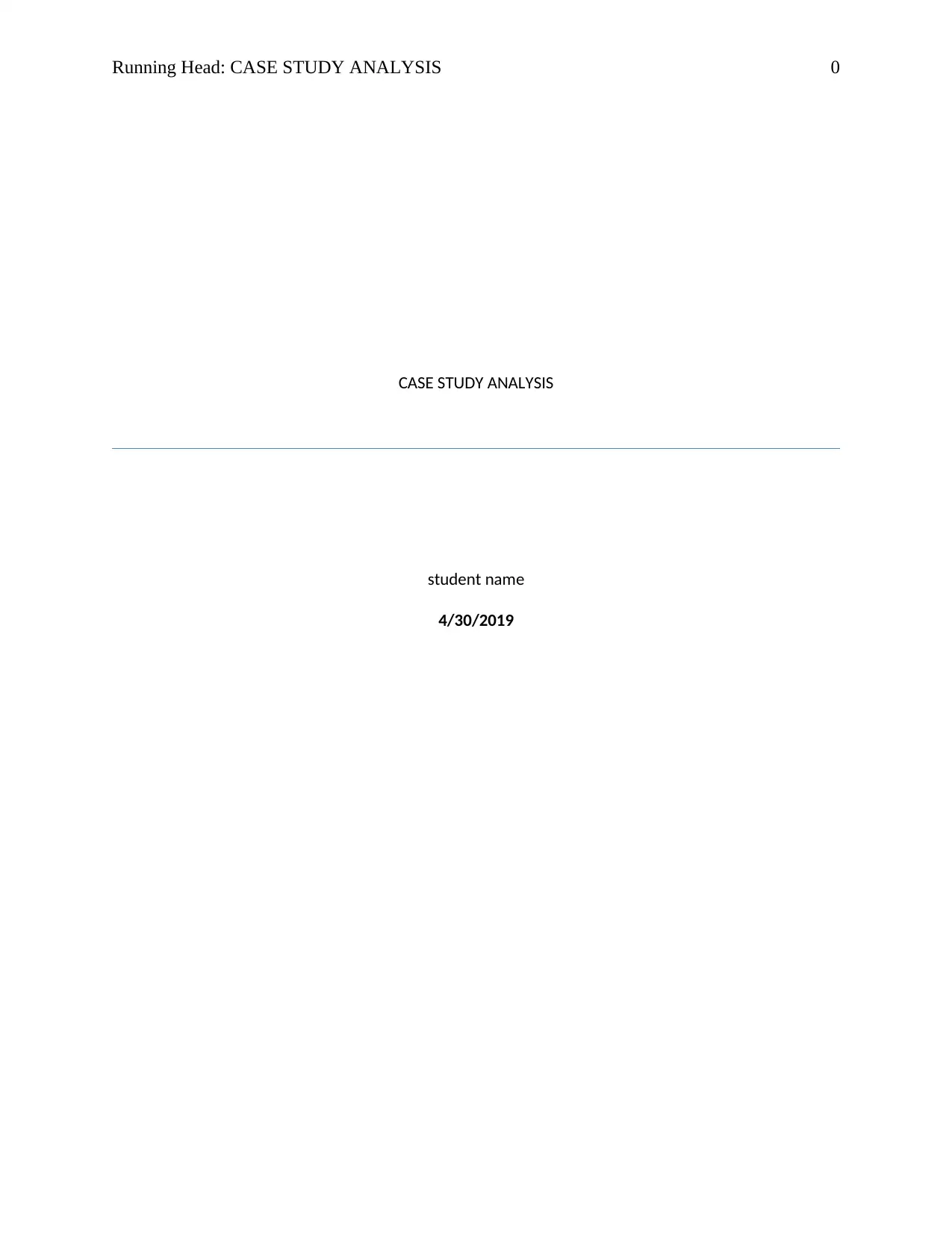
Running Head: CASE STUDY ANALYSIS 0
CASE STUDY ANALYSIS
student name
4/30/2019
CASE STUDY ANALYSIS
student name
4/30/2019
Paraphrase This Document
Need a fresh take? Get an instant paraphrase of this document with our AI Paraphraser
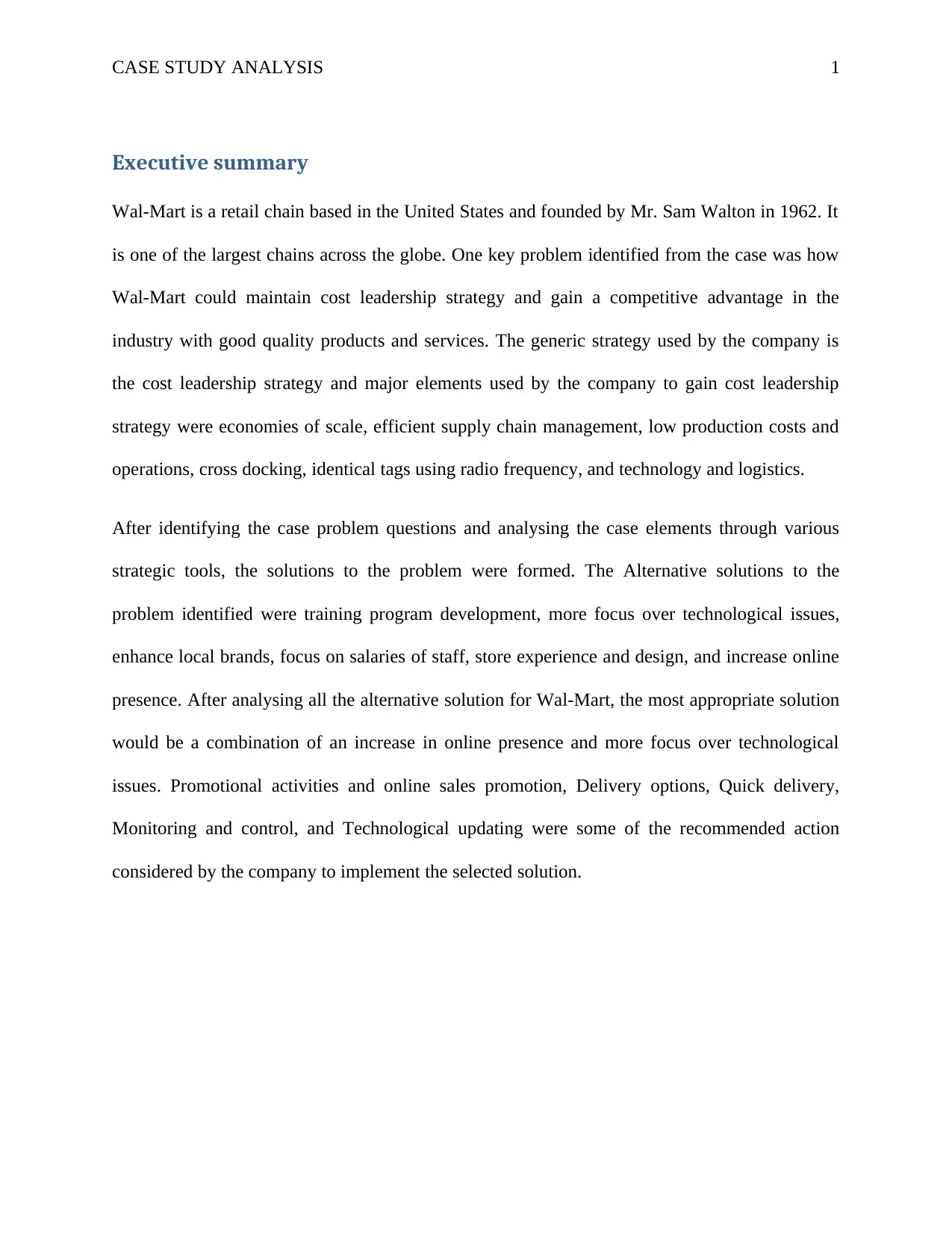
CASE STUDY ANALYSIS 1
Executive summary
Wal-Mart is a retail chain based in the United States and founded by Mr. Sam Walton in 1962. It
is one of the largest chains across the globe. One key problem identified from the case was how
Wal-Mart could maintain cost leadership strategy and gain a competitive advantage in the
industry with good quality products and services. The generic strategy used by the company is
the cost leadership strategy and major elements used by the company to gain cost leadership
strategy were economies of scale, efficient supply chain management, low production costs and
operations, cross docking, identical tags using radio frequency, and technology and logistics.
After identifying the case problem questions and analysing the case elements through various
strategic tools, the solutions to the problem were formed. The Alternative solutions to the
problem identified were training program development, more focus over technological issues,
enhance local brands, focus on salaries of staff, store experience and design, and increase online
presence. After analysing all the alternative solution for Wal-Mart, the most appropriate solution
would be a combination of an increase in online presence and more focus over technological
issues. Promotional activities and online sales promotion, Delivery options, Quick delivery,
Monitoring and control, and Technological updating were some of the recommended action
considered by the company to implement the selected solution.
Executive summary
Wal-Mart is a retail chain based in the United States and founded by Mr. Sam Walton in 1962. It
is one of the largest chains across the globe. One key problem identified from the case was how
Wal-Mart could maintain cost leadership strategy and gain a competitive advantage in the
industry with good quality products and services. The generic strategy used by the company is
the cost leadership strategy and major elements used by the company to gain cost leadership
strategy were economies of scale, efficient supply chain management, low production costs and
operations, cross docking, identical tags using radio frequency, and technology and logistics.
After identifying the case problem questions and analysing the case elements through various
strategic tools, the solutions to the problem were formed. The Alternative solutions to the
problem identified were training program development, more focus over technological issues,
enhance local brands, focus on salaries of staff, store experience and design, and increase online
presence. After analysing all the alternative solution for Wal-Mart, the most appropriate solution
would be a combination of an increase in online presence and more focus over technological
issues. Promotional activities and online sales promotion, Delivery options, Quick delivery,
Monitoring and control, and Technological updating were some of the recommended action
considered by the company to implement the selected solution.
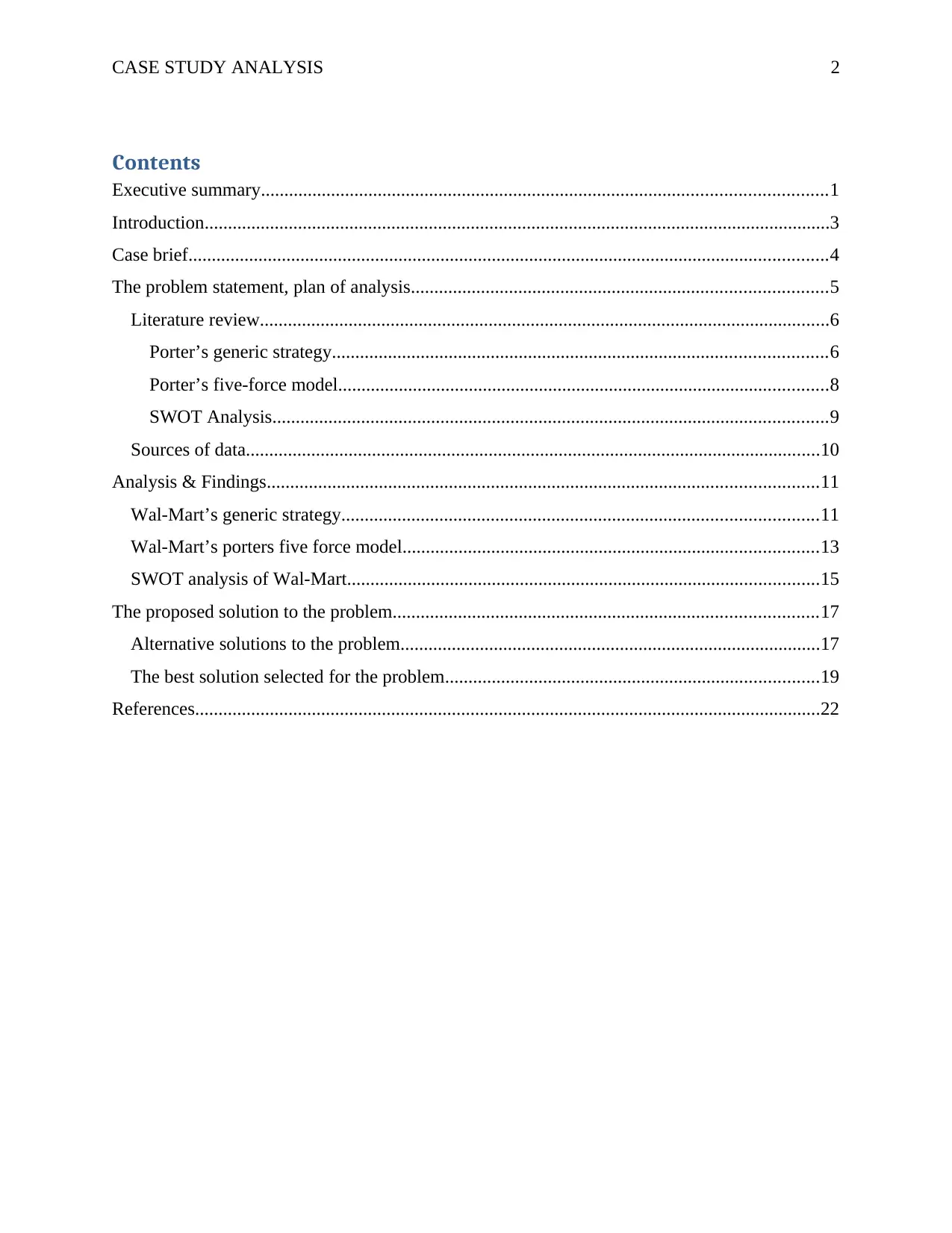
CASE STUDY ANALYSIS 2
Contents
Executive summary.........................................................................................................................1
Introduction......................................................................................................................................3
Case brief.........................................................................................................................................4
The problem statement, plan of analysis.........................................................................................5
Literature review..........................................................................................................................6
Porter’s generic strategy..........................................................................................................6
Porter’s five-force model.........................................................................................................8
SWOT Analysis.......................................................................................................................9
Sources of data...........................................................................................................................10
Analysis & Findings......................................................................................................................11
Wal-Mart’s generic strategy......................................................................................................11
Wal-Mart’s porters five force model.........................................................................................13
SWOT analysis of Wal-Mart.....................................................................................................15
The proposed solution to the problem...........................................................................................17
Alternative solutions to the problem..........................................................................................17
The best solution selected for the problem................................................................................19
References......................................................................................................................................22
Contents
Executive summary.........................................................................................................................1
Introduction......................................................................................................................................3
Case brief.........................................................................................................................................4
The problem statement, plan of analysis.........................................................................................5
Literature review..........................................................................................................................6
Porter’s generic strategy..........................................................................................................6
Porter’s five-force model.........................................................................................................8
SWOT Analysis.......................................................................................................................9
Sources of data...........................................................................................................................10
Analysis & Findings......................................................................................................................11
Wal-Mart’s generic strategy......................................................................................................11
Wal-Mart’s porters five force model.........................................................................................13
SWOT analysis of Wal-Mart.....................................................................................................15
The proposed solution to the problem...........................................................................................17
Alternative solutions to the problem..........................................................................................17
The best solution selected for the problem................................................................................19
References......................................................................................................................................22
⊘ This is a preview!⊘
Do you want full access?
Subscribe today to unlock all pages.

Trusted by 1+ million students worldwide
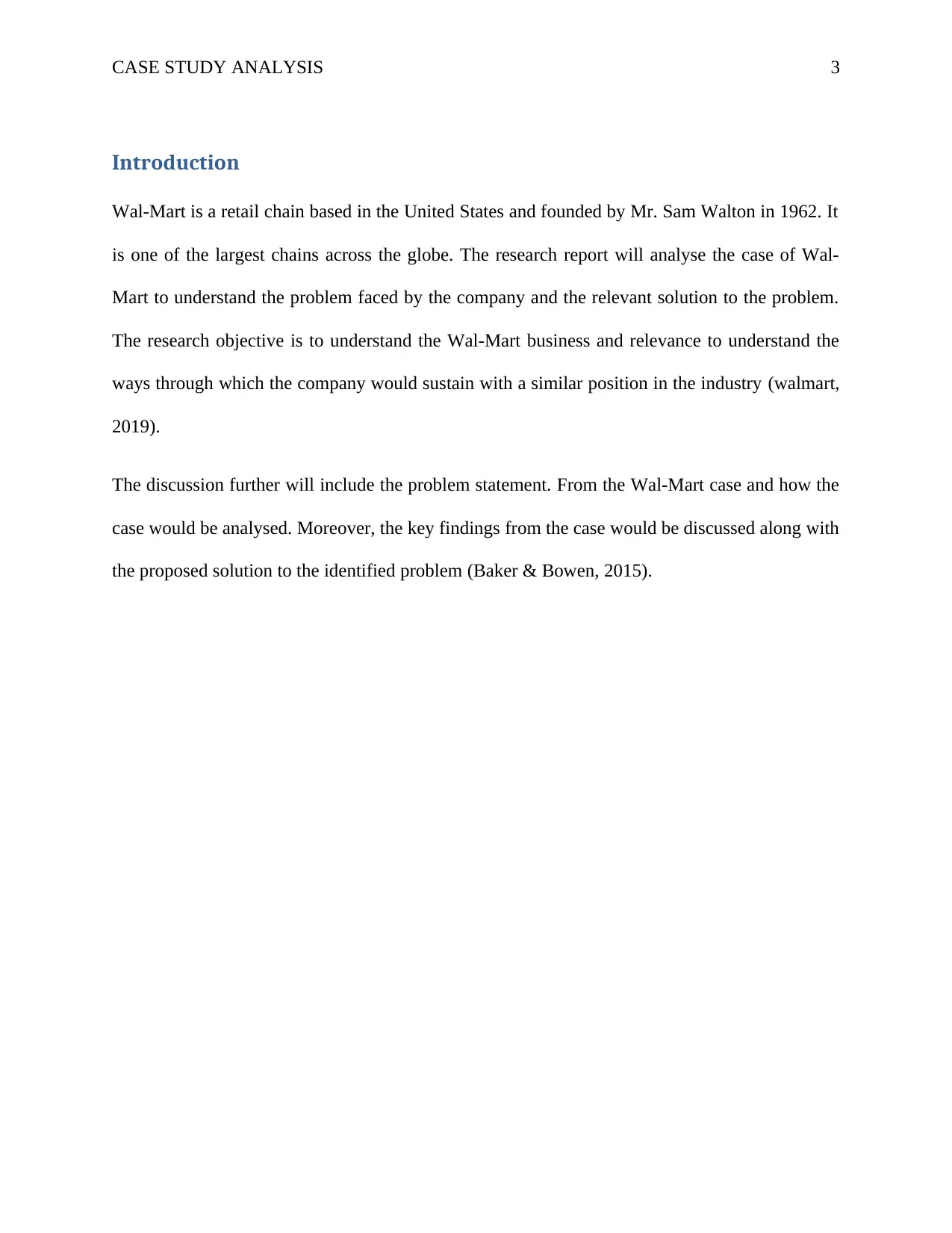
CASE STUDY ANALYSIS 3
Introduction
Wal-Mart is a retail chain based in the United States and founded by Mr. Sam Walton in 1962. It
is one of the largest chains across the globe. The research report will analyse the case of Wal-
Mart to understand the problem faced by the company and the relevant solution to the problem.
The research objective is to understand the Wal-Mart business and relevance to understand the
ways through which the company would sustain with a similar position in the industry (walmart,
2019).
The discussion further will include the problem statement. From the Wal-Mart case and how the
case would be analysed. Moreover, the key findings from the case would be discussed along with
the proposed solution to the identified problem (Baker & Bowen, 2015).
Introduction
Wal-Mart is a retail chain based in the United States and founded by Mr. Sam Walton in 1962. It
is one of the largest chains across the globe. The research report will analyse the case of Wal-
Mart to understand the problem faced by the company and the relevant solution to the problem.
The research objective is to understand the Wal-Mart business and relevance to understand the
ways through which the company would sustain with a similar position in the industry (walmart,
2019).
The discussion further will include the problem statement. From the Wal-Mart case and how the
case would be analysed. Moreover, the key findings from the case would be discussed along with
the proposed solution to the identified problem (Baker & Bowen, 2015).
Paraphrase This Document
Need a fresh take? Get an instant paraphrase of this document with our AI Paraphraser
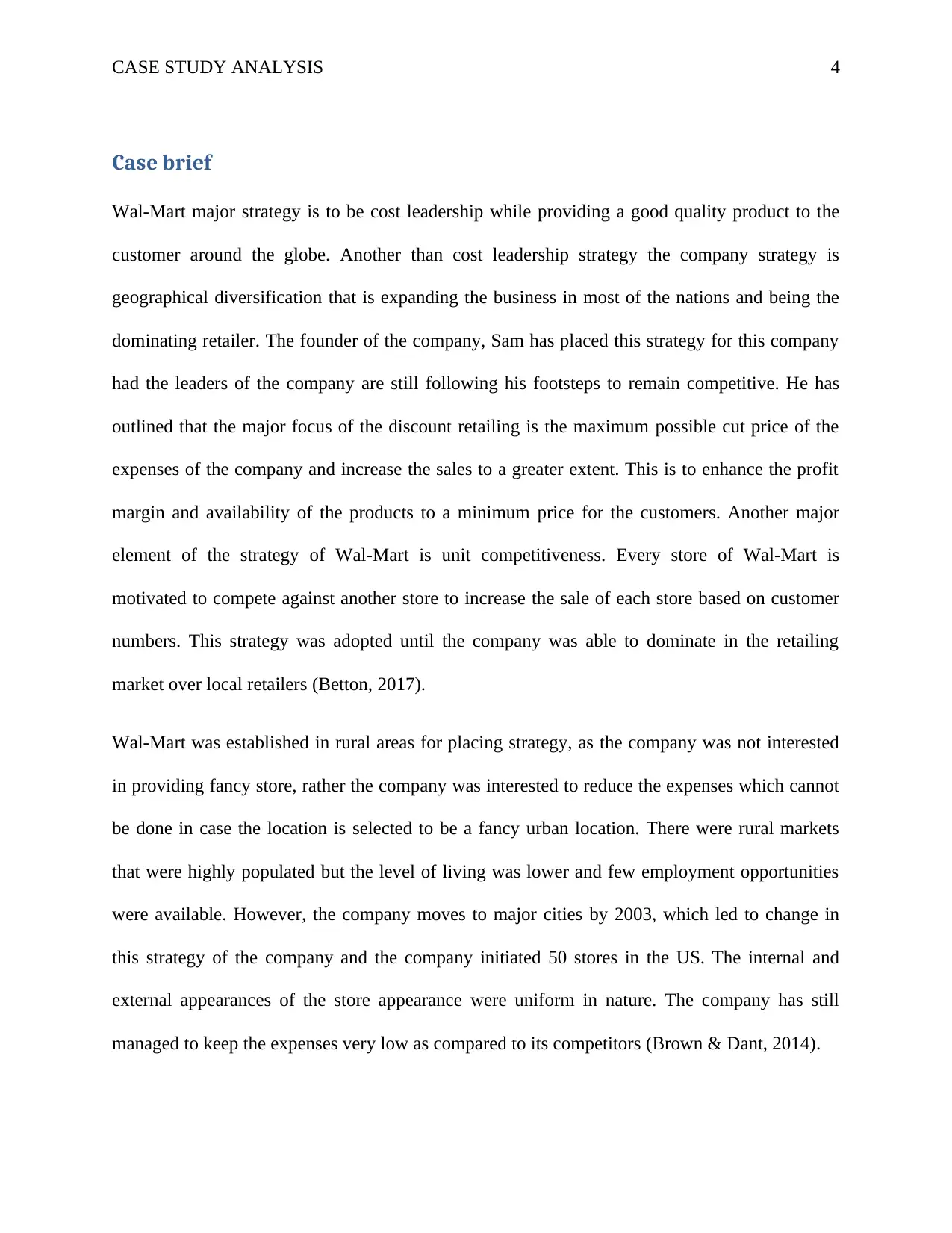
CASE STUDY ANALYSIS 4
Case brief
Wal-Mart major strategy is to be cost leadership while providing a good quality product to the
customer around the globe. Another than cost leadership strategy the company strategy is
geographical diversification that is expanding the business in most of the nations and being the
dominating retailer. The founder of the company, Sam has placed this strategy for this company
had the leaders of the company are still following his footsteps to remain competitive. He has
outlined that the major focus of the discount retailing is the maximum possible cut price of the
expenses of the company and increase the sales to a greater extent. This is to enhance the profit
margin and availability of the products to a minimum price for the customers. Another major
element of the strategy of Wal-Mart is unit competitiveness. Every store of Wal-Mart is
motivated to compete against another store to increase the sale of each store based on customer
numbers. This strategy was adopted until the company was able to dominate in the retailing
market over local retailers (Betton, 2017).
Wal-Mart was established in rural areas for placing strategy, as the company was not interested
in providing fancy store, rather the company was interested to reduce the expenses which cannot
be done in case the location is selected to be a fancy urban location. There were rural markets
that were highly populated but the level of living was lower and few employment opportunities
were available. However, the company moves to major cities by 2003, which led to change in
this strategy of the company and the company initiated 50 stores in the US. The internal and
external appearances of the store appearance were uniform in nature. The company has still
managed to keep the expenses very low as compared to its competitors (Brown & Dant, 2014).
Case brief
Wal-Mart major strategy is to be cost leadership while providing a good quality product to the
customer around the globe. Another than cost leadership strategy the company strategy is
geographical diversification that is expanding the business in most of the nations and being the
dominating retailer. The founder of the company, Sam has placed this strategy for this company
had the leaders of the company are still following his footsteps to remain competitive. He has
outlined that the major focus of the discount retailing is the maximum possible cut price of the
expenses of the company and increase the sales to a greater extent. This is to enhance the profit
margin and availability of the products to a minimum price for the customers. Another major
element of the strategy of Wal-Mart is unit competitiveness. Every store of Wal-Mart is
motivated to compete against another store to increase the sale of each store based on customer
numbers. This strategy was adopted until the company was able to dominate in the retailing
market over local retailers (Betton, 2017).
Wal-Mart was established in rural areas for placing strategy, as the company was not interested
in providing fancy store, rather the company was interested to reduce the expenses which cannot
be done in case the location is selected to be a fancy urban location. There were rural markets
that were highly populated but the level of living was lower and few employment opportunities
were available. However, the company moves to major cities by 2003, which led to change in
this strategy of the company and the company initiated 50 stores in the US. The internal and
external appearances of the store appearance were uniform in nature. The company has still
managed to keep the expenses very low as compared to its competitors (Brown & Dant, 2014).
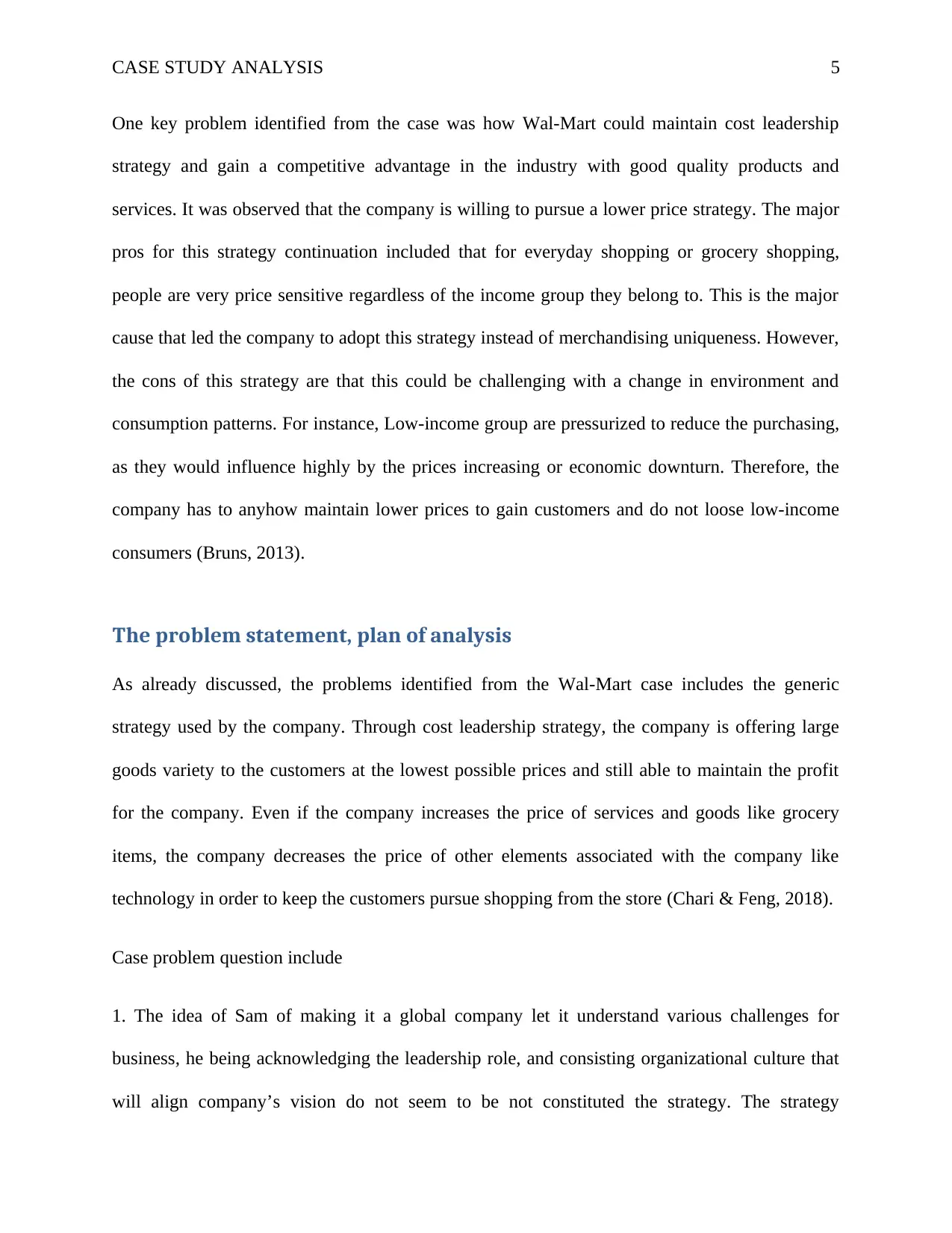
CASE STUDY ANALYSIS 5
One key problem identified from the case was how Wal-Mart could maintain cost leadership
strategy and gain a competitive advantage in the industry with good quality products and
services. It was observed that the company is willing to pursue a lower price strategy. The major
pros for this strategy continuation included that for everyday shopping or grocery shopping,
people are very price sensitive regardless of the income group they belong to. This is the major
cause that led the company to adopt this strategy instead of merchandising uniqueness. However,
the cons of this strategy are that this could be challenging with a change in environment and
consumption patterns. For instance, Low-income group are pressurized to reduce the purchasing,
as they would influence highly by the prices increasing or economic downturn. Therefore, the
company has to anyhow maintain lower prices to gain customers and do not loose low-income
consumers (Bruns, 2013).
The problem statement, plan of analysis
As already discussed, the problems identified from the Wal-Mart case includes the generic
strategy used by the company. Through cost leadership strategy, the company is offering large
goods variety to the customers at the lowest possible prices and still able to maintain the profit
for the company. Even if the company increases the price of services and goods like grocery
items, the company decreases the price of other elements associated with the company like
technology in order to keep the customers pursue shopping from the store (Chari & Feng, 2018).
Case problem question include
1. The idea of Sam of making it a global company let it understand various challenges for
business, he being acknowledging the leadership role, and consisting organizational culture that
will align company’s vision do not seem to be not constituted the strategy. The strategy
One key problem identified from the case was how Wal-Mart could maintain cost leadership
strategy and gain a competitive advantage in the industry with good quality products and
services. It was observed that the company is willing to pursue a lower price strategy. The major
pros for this strategy continuation included that for everyday shopping or grocery shopping,
people are very price sensitive regardless of the income group they belong to. This is the major
cause that led the company to adopt this strategy instead of merchandising uniqueness. However,
the cons of this strategy are that this could be challenging with a change in environment and
consumption patterns. For instance, Low-income group are pressurized to reduce the purchasing,
as they would influence highly by the prices increasing or economic downturn. Therefore, the
company has to anyhow maintain lower prices to gain customers and do not loose low-income
consumers (Bruns, 2013).
The problem statement, plan of analysis
As already discussed, the problems identified from the Wal-Mart case includes the generic
strategy used by the company. Through cost leadership strategy, the company is offering large
goods variety to the customers at the lowest possible prices and still able to maintain the profit
for the company. Even if the company increases the price of services and goods like grocery
items, the company decreases the price of other elements associated with the company like
technology in order to keep the customers pursue shopping from the store (Chari & Feng, 2018).
Case problem question include
1. The idea of Sam of making it a global company let it understand various challenges for
business, he being acknowledging the leadership role, and consisting organizational culture that
will align company’s vision do not seem to be not constituted the strategy. The strategy
⊘ This is a preview!⊘
Do you want full access?
Subscribe today to unlock all pages.

Trusted by 1+ million students worldwide
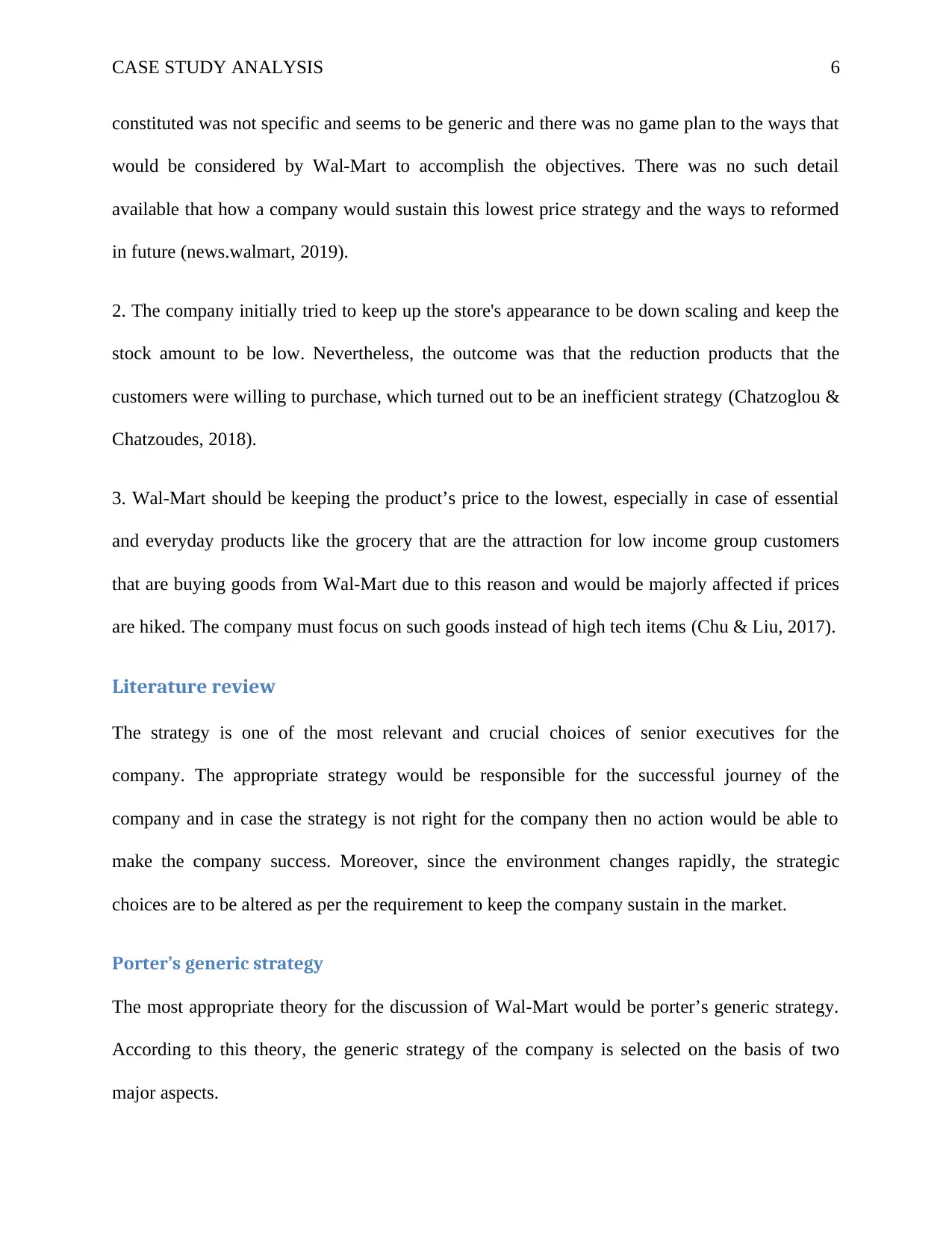
CASE STUDY ANALYSIS 6
constituted was not specific and seems to be generic and there was no game plan to the ways that
would be considered by Wal-Mart to accomplish the objectives. There was no such detail
available that how a company would sustain this lowest price strategy and the ways to reformed
in future (news.walmart, 2019).
2. The company initially tried to keep up the store's appearance to be down scaling and keep the
stock amount to be low. Nevertheless, the outcome was that the reduction products that the
customers were willing to purchase, which turned out to be an inefficient strategy (Chatzoglou &
Chatzoudes, 2018).
3. Wal-Mart should be keeping the product’s price to the lowest, especially in case of essential
and everyday products like the grocery that are the attraction for low income group customers
that are buying goods from Wal-Mart due to this reason and would be majorly affected if prices
are hiked. The company must focus on such goods instead of high tech items (Chu & Liu, 2017).
Literature review
The strategy is one of the most relevant and crucial choices of senior executives for the
company. The appropriate strategy would be responsible for the successful journey of the
company and in case the strategy is not right for the company then no action would be able to
make the company success. Moreover, since the environment changes rapidly, the strategic
choices are to be altered as per the requirement to keep the company sustain in the market.
Porter’s generic strategy
The most appropriate theory for the discussion of Wal-Mart would be porter’s generic strategy.
According to this theory, the generic strategy of the company is selected on the basis of two
major aspects.
constituted was not specific and seems to be generic and there was no game plan to the ways that
would be considered by Wal-Mart to accomplish the objectives. There was no such detail
available that how a company would sustain this lowest price strategy and the ways to reformed
in future (news.walmart, 2019).
2. The company initially tried to keep up the store's appearance to be down scaling and keep the
stock amount to be low. Nevertheless, the outcome was that the reduction products that the
customers were willing to purchase, which turned out to be an inefficient strategy (Chatzoglou &
Chatzoudes, 2018).
3. Wal-Mart should be keeping the product’s price to the lowest, especially in case of essential
and everyday products like the grocery that are the attraction for low income group customers
that are buying goods from Wal-Mart due to this reason and would be majorly affected if prices
are hiked. The company must focus on such goods instead of high tech items (Chu & Liu, 2017).
Literature review
The strategy is one of the most relevant and crucial choices of senior executives for the
company. The appropriate strategy would be responsible for the successful journey of the
company and in case the strategy is not right for the company then no action would be able to
make the company success. Moreover, since the environment changes rapidly, the strategic
choices are to be altered as per the requirement to keep the company sustain in the market.
Porter’s generic strategy
The most appropriate theory for the discussion of Wal-Mart would be porter’s generic strategy.
According to this theory, the generic strategy of the company is selected on the basis of two
major aspects.
Paraphrase This Document
Need a fresh take? Get an instant paraphrase of this document with our AI Paraphraser
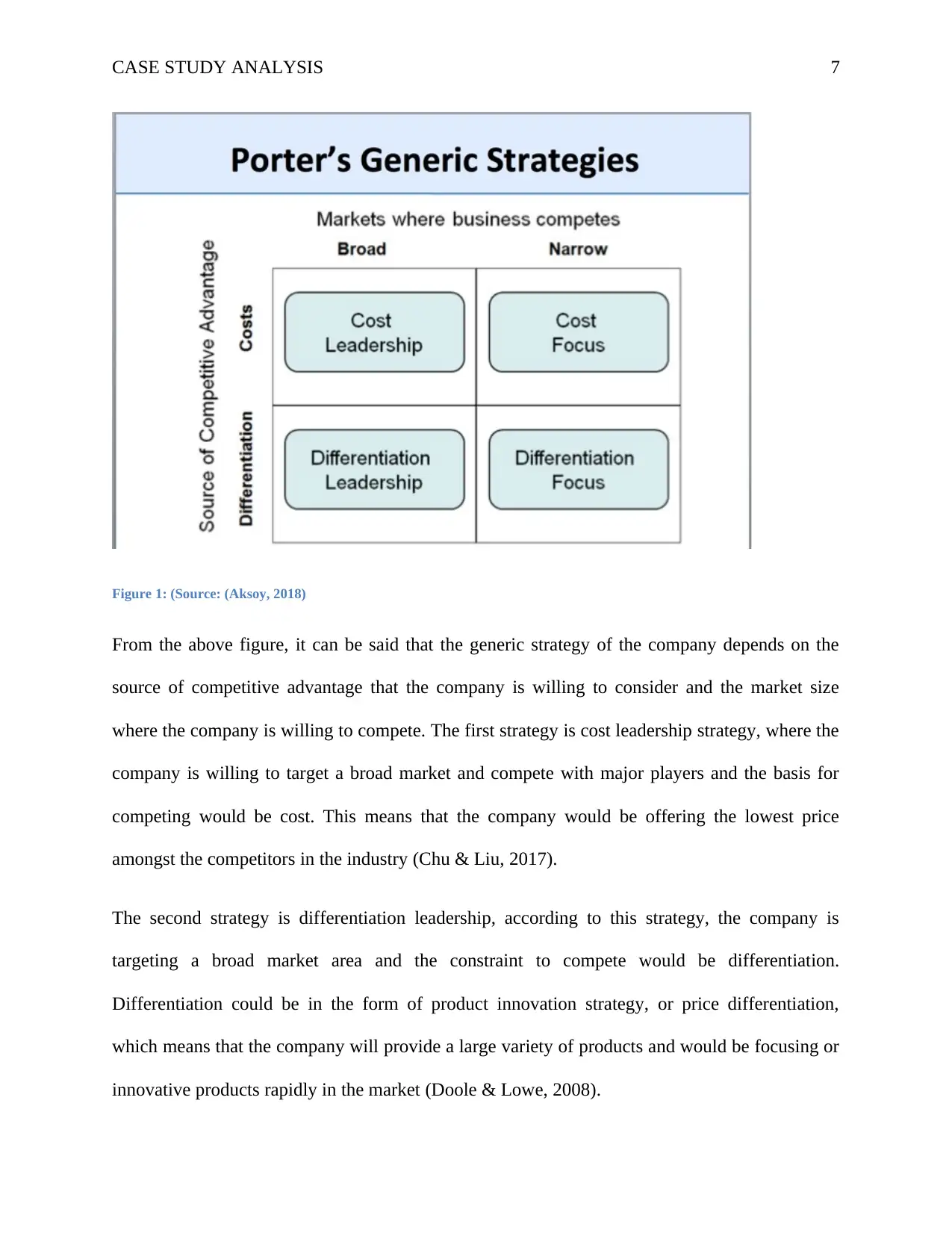
CASE STUDY ANALYSIS 7
Figure 1: (Source: (Aksoy, 2018)
From the above figure, it can be said that the generic strategy of the company depends on the
source of competitive advantage that the company is willing to consider and the market size
where the company is willing to compete. The first strategy is cost leadership strategy, where the
company is willing to target a broad market and compete with major players and the basis for
competing would be cost. This means that the company would be offering the lowest price
amongst the competitors in the industry (Chu & Liu, 2017).
The second strategy is differentiation leadership, according to this strategy, the company is
targeting a broad market area and the constraint to compete would be differentiation.
Differentiation could be in the form of product innovation strategy, or price differentiation,
which means that the company will provide a large variety of products and would be focusing or
innovative products rapidly in the market (Doole & Lowe, 2008).
Figure 1: (Source: (Aksoy, 2018)
From the above figure, it can be said that the generic strategy of the company depends on the
source of competitive advantage that the company is willing to consider and the market size
where the company is willing to compete. The first strategy is cost leadership strategy, where the
company is willing to target a broad market and compete with major players and the basis for
competing would be cost. This means that the company would be offering the lowest price
amongst the competitors in the industry (Chu & Liu, 2017).
The second strategy is differentiation leadership, according to this strategy, the company is
targeting a broad market area and the constraint to compete would be differentiation.
Differentiation could be in the form of product innovation strategy, or price differentiation,
which means that the company will provide a large variety of products and would be focusing or
innovative products rapidly in the market (Doole & Lowe, 2008).
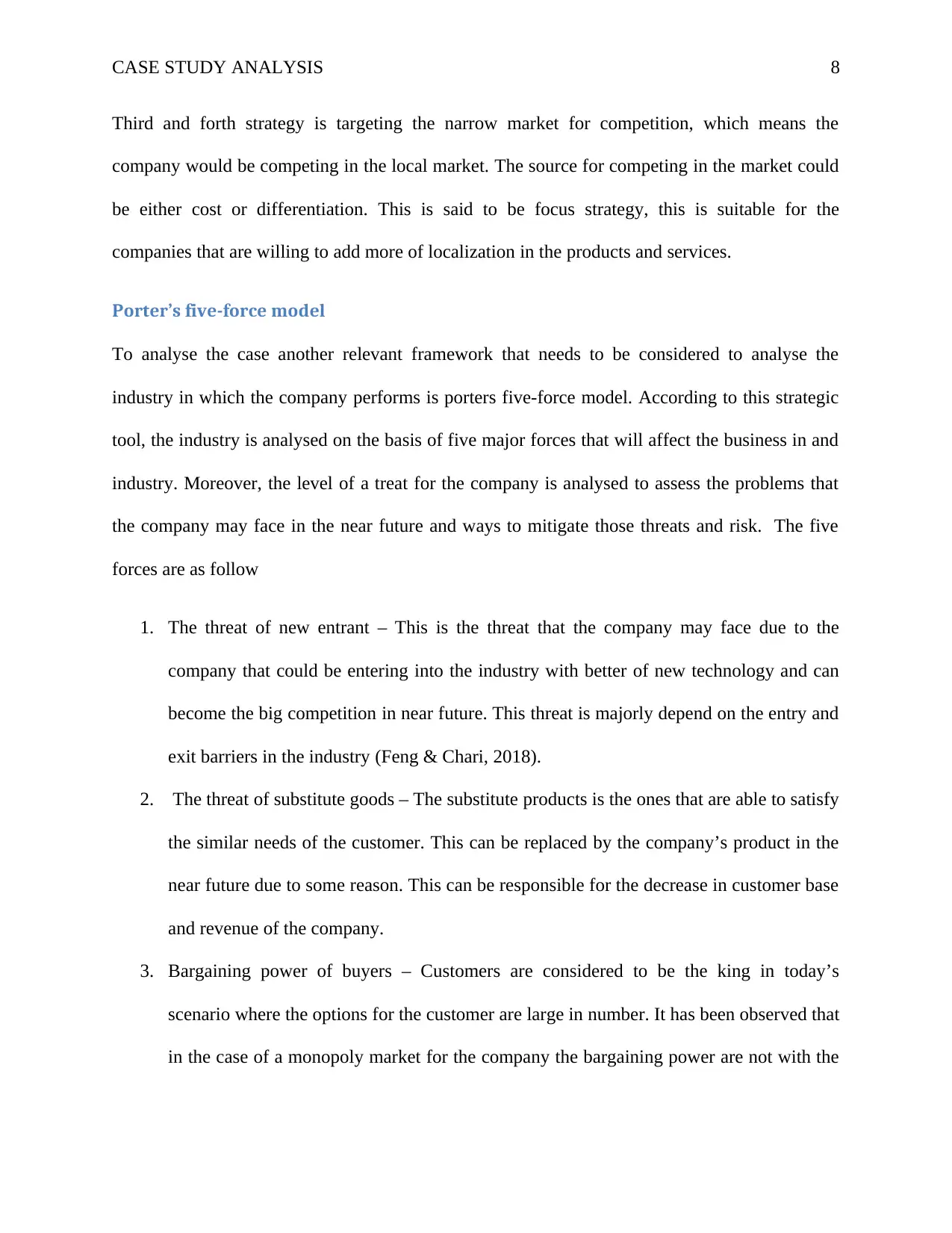
CASE STUDY ANALYSIS 8
Third and forth strategy is targeting the narrow market for competition, which means the
company would be competing in the local market. The source for competing in the market could
be either cost or differentiation. This is said to be focus strategy, this is suitable for the
companies that are willing to add more of localization in the products and services.
Porter’s five-force model
To analyse the case another relevant framework that needs to be considered to analyse the
industry in which the company performs is porters five-force model. According to this strategic
tool, the industry is analysed on the basis of five major forces that will affect the business in and
industry. Moreover, the level of a treat for the company is analysed to assess the problems that
the company may face in the near future and ways to mitigate those threats and risk. The five
forces are as follow
1. The threat of new entrant – This is the threat that the company may face due to the
company that could be entering into the industry with better of new technology and can
become the big competition in near future. This threat is majorly depend on the entry and
exit barriers in the industry (Feng & Chari, 2018).
2. The threat of substitute goods – The substitute products is the ones that are able to satisfy
the similar needs of the customer. This can be replaced by the company’s product in the
near future due to some reason. This can be responsible for the decrease in customer base
and revenue of the company.
3. Bargaining power of buyers – Customers are considered to be the king in today’s
scenario where the options for the customer are large in number. It has been observed that
in the case of a monopoly market for the company the bargaining power are not with the
Third and forth strategy is targeting the narrow market for competition, which means the
company would be competing in the local market. The source for competing in the market could
be either cost or differentiation. This is said to be focus strategy, this is suitable for the
companies that are willing to add more of localization in the products and services.
Porter’s five-force model
To analyse the case another relevant framework that needs to be considered to analyse the
industry in which the company performs is porters five-force model. According to this strategic
tool, the industry is analysed on the basis of five major forces that will affect the business in and
industry. Moreover, the level of a treat for the company is analysed to assess the problems that
the company may face in the near future and ways to mitigate those threats and risk. The five
forces are as follow
1. The threat of new entrant – This is the threat that the company may face due to the
company that could be entering into the industry with better of new technology and can
become the big competition in near future. This threat is majorly depend on the entry and
exit barriers in the industry (Feng & Chari, 2018).
2. The threat of substitute goods – The substitute products is the ones that are able to satisfy
the similar needs of the customer. This can be replaced by the company’s product in the
near future due to some reason. This can be responsible for the decrease in customer base
and revenue of the company.
3. Bargaining power of buyers – Customers are considered to be the king in today’s
scenario where the options for the customer are large in number. It has been observed that
in the case of a monopoly market for the company the bargaining power are not with the
⊘ This is a preview!⊘
Do you want full access?
Subscribe today to unlock all pages.

Trusted by 1+ million students worldwide
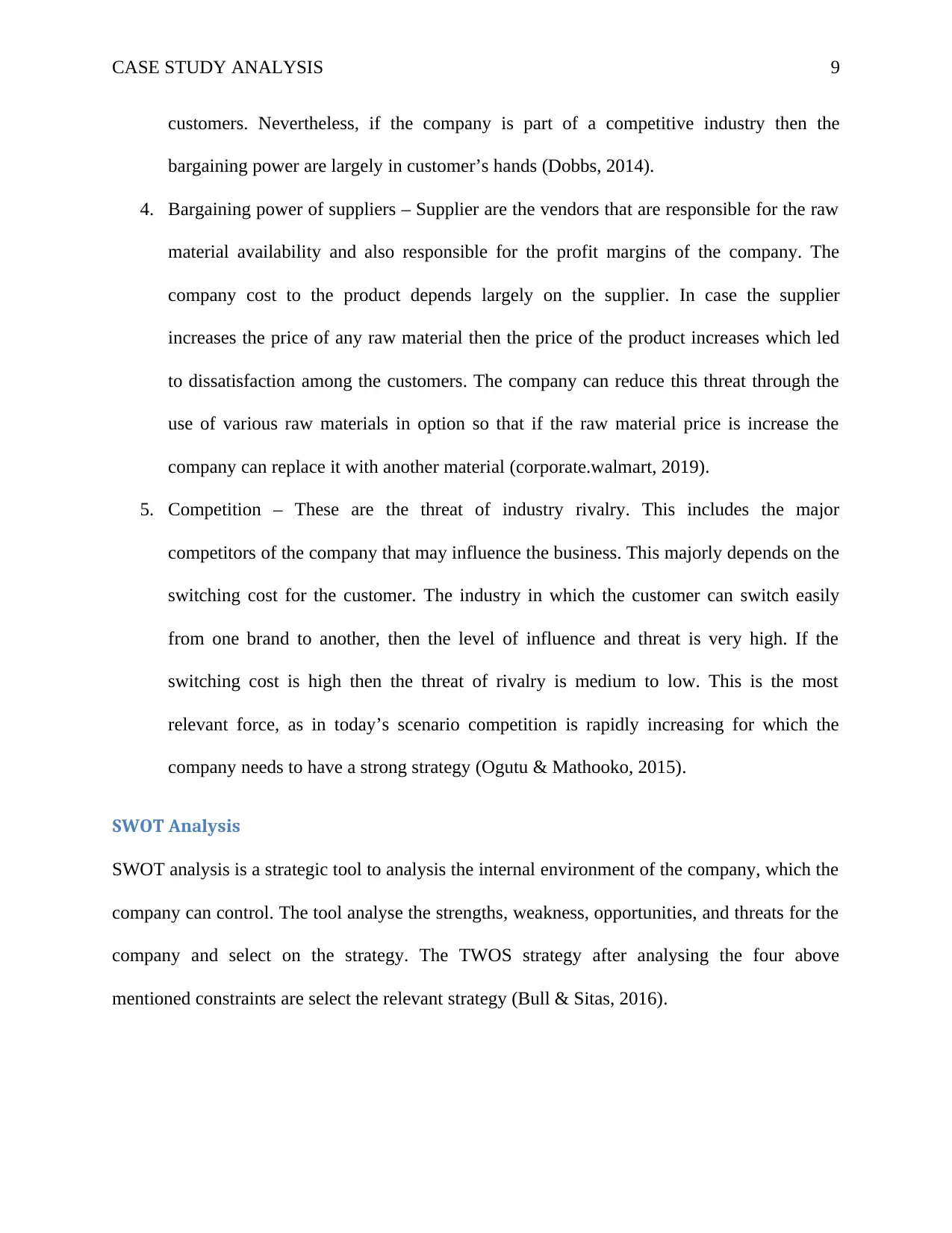
CASE STUDY ANALYSIS 9
customers. Nevertheless, if the company is part of a competitive industry then the
bargaining power are largely in customer’s hands (Dobbs, 2014).
4. Bargaining power of suppliers – Supplier are the vendors that are responsible for the raw
material availability and also responsible for the profit margins of the company. The
company cost to the product depends largely on the supplier. In case the supplier
increases the price of any raw material then the price of the product increases which led
to dissatisfaction among the customers. The company can reduce this threat through the
use of various raw materials in option so that if the raw material price is increase the
company can replace it with another material (corporate.walmart, 2019).
5. Competition – These are the threat of industry rivalry. This includes the major
competitors of the company that may influence the business. This majorly depends on the
switching cost for the customer. The industry in which the customer can switch easily
from one brand to another, then the level of influence and threat is very high. If the
switching cost is high then the threat of rivalry is medium to low. This is the most
relevant force, as in today’s scenario competition is rapidly increasing for which the
company needs to have a strong strategy (Ogutu & Mathooko, 2015).
SWOT Analysis
SWOT analysis is a strategic tool to analysis the internal environment of the company, which the
company can control. The tool analyse the strengths, weakness, opportunities, and threats for the
company and select on the strategy. The TWOS strategy after analysing the four above
mentioned constraints are select the relevant strategy (Bull & Sitas, 2016).
customers. Nevertheless, if the company is part of a competitive industry then the
bargaining power are largely in customer’s hands (Dobbs, 2014).
4. Bargaining power of suppliers – Supplier are the vendors that are responsible for the raw
material availability and also responsible for the profit margins of the company. The
company cost to the product depends largely on the supplier. In case the supplier
increases the price of any raw material then the price of the product increases which led
to dissatisfaction among the customers. The company can reduce this threat through the
use of various raw materials in option so that if the raw material price is increase the
company can replace it with another material (corporate.walmart, 2019).
5. Competition – These are the threat of industry rivalry. This includes the major
competitors of the company that may influence the business. This majorly depends on the
switching cost for the customer. The industry in which the customer can switch easily
from one brand to another, then the level of influence and threat is very high. If the
switching cost is high then the threat of rivalry is medium to low. This is the most
relevant force, as in today’s scenario competition is rapidly increasing for which the
company needs to have a strong strategy (Ogutu & Mathooko, 2015).
SWOT Analysis
SWOT analysis is a strategic tool to analysis the internal environment of the company, which the
company can control. The tool analyse the strengths, weakness, opportunities, and threats for the
company and select on the strategy. The TWOS strategy after analysing the four above
mentioned constraints are select the relevant strategy (Bull & Sitas, 2016).
Paraphrase This Document
Need a fresh take? Get an instant paraphrase of this document with our AI Paraphraser
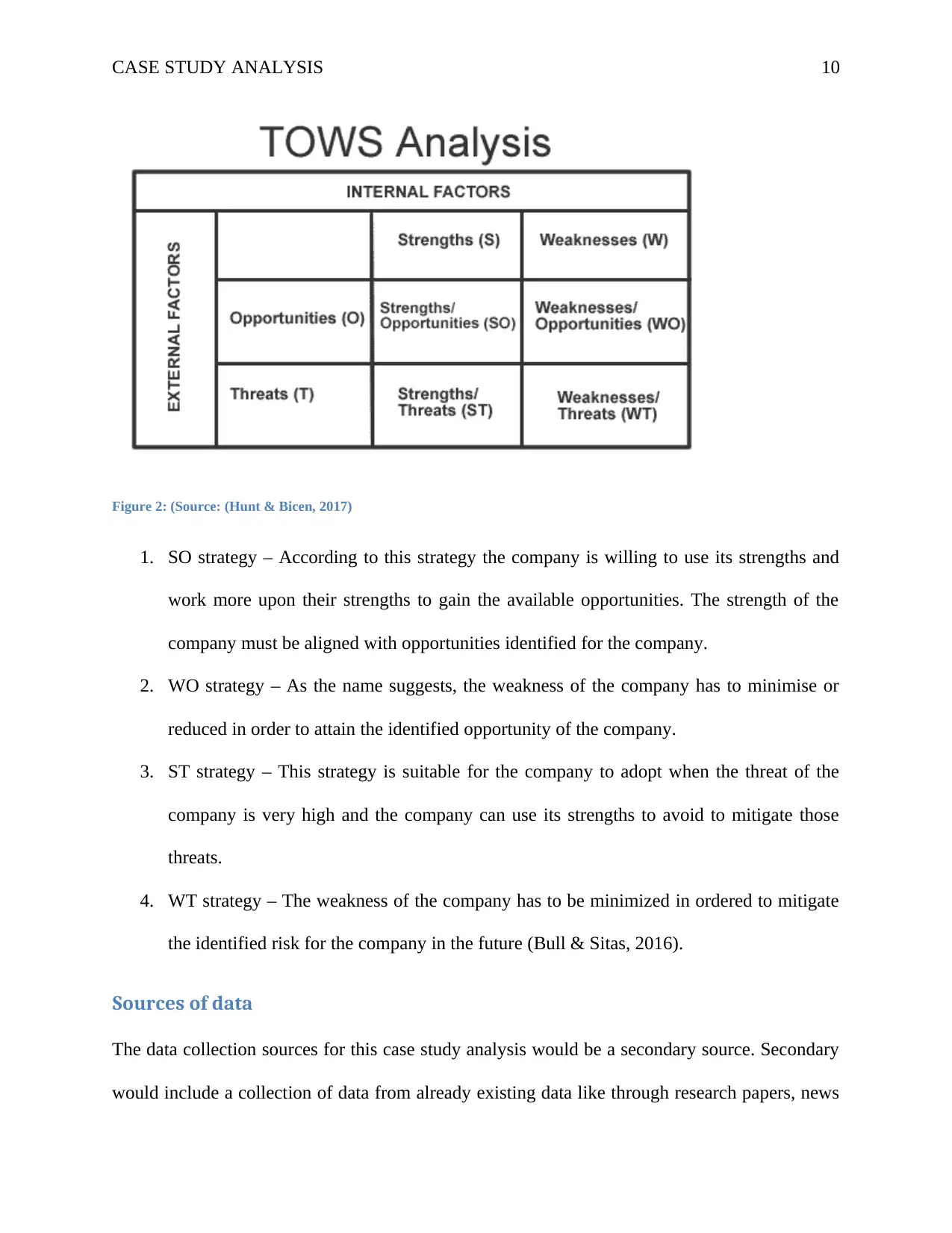
CASE STUDY ANALYSIS 10
Figure 2: (Source: (Hunt & Bicen, 2017)
1. SO strategy – According to this strategy the company is willing to use its strengths and
work more upon their strengths to gain the available opportunities. The strength of the
company must be aligned with opportunities identified for the company.
2. WO strategy – As the name suggests, the weakness of the company has to minimise or
reduced in order to attain the identified opportunity of the company.
3. ST strategy – This strategy is suitable for the company to adopt when the threat of the
company is very high and the company can use its strengths to avoid to mitigate those
threats.
4. WT strategy – The weakness of the company has to be minimized in ordered to mitigate
the identified risk for the company in the future (Bull & Sitas, 2016).
Sources of data
The data collection sources for this case study analysis would be a secondary source. Secondary
would include a collection of data from already existing data like through research papers, news
Figure 2: (Source: (Hunt & Bicen, 2017)
1. SO strategy – According to this strategy the company is willing to use its strengths and
work more upon their strengths to gain the available opportunities. The strength of the
company must be aligned with opportunities identified for the company.
2. WO strategy – As the name suggests, the weakness of the company has to minimise or
reduced in order to attain the identified opportunity of the company.
3. ST strategy – This strategy is suitable for the company to adopt when the threat of the
company is very high and the company can use its strengths to avoid to mitigate those
threats.
4. WT strategy – The weakness of the company has to be minimized in ordered to mitigate
the identified risk for the company in the future (Bull & Sitas, 2016).
Sources of data
The data collection sources for this case study analysis would be a secondary source. Secondary
would include a collection of data from already existing data like through research papers, news
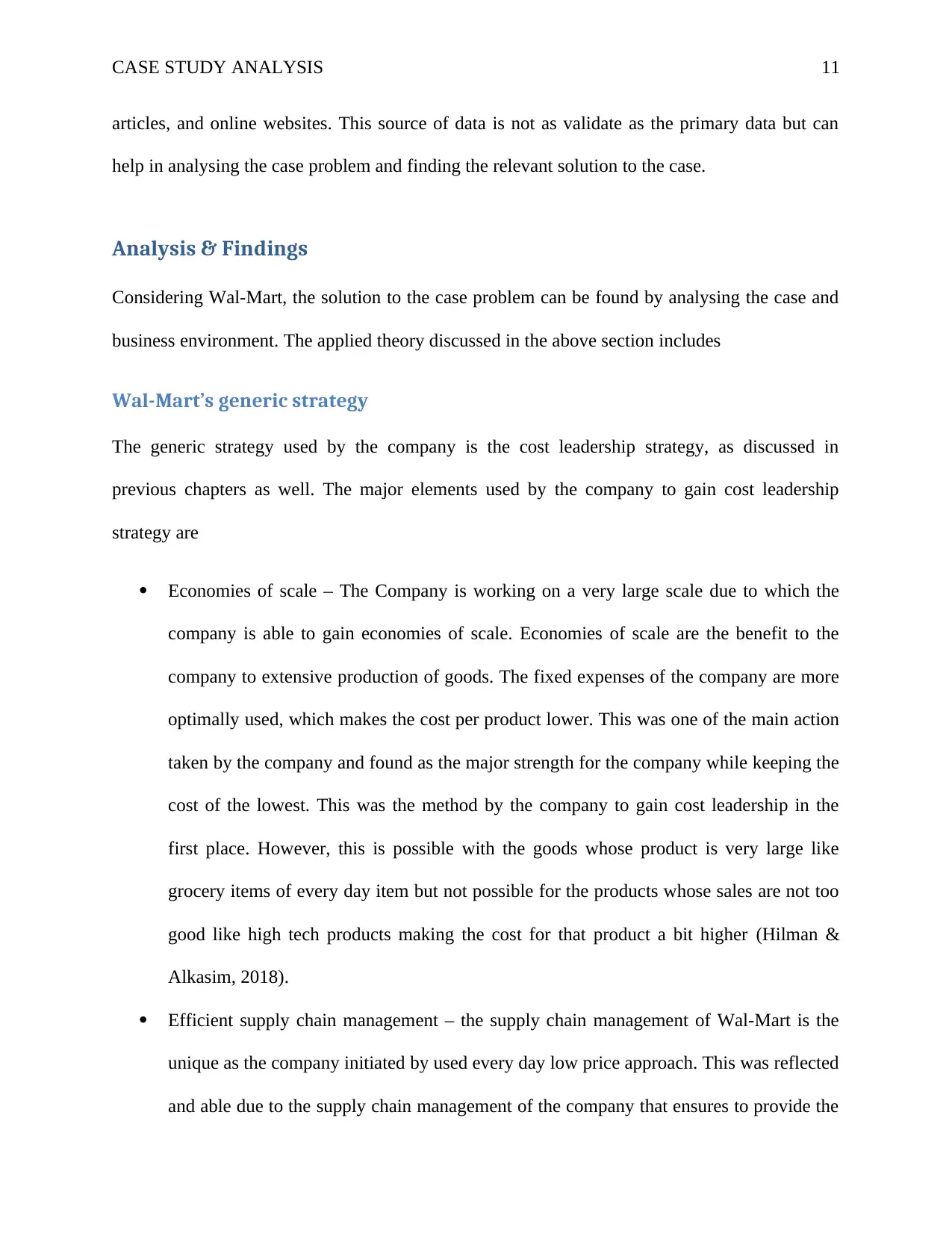
CASE STUDY ANALYSIS 11
articles, and online websites. This source of data is not as validate as the primary data but can
help in analysing the case problem and finding the relevant solution to the case.
Analysis & Findings
Considering Wal-Mart, the solution to the case problem can be found by analysing the case and
business environment. The applied theory discussed in the above section includes
Wal-Mart’s generic strategy
The generic strategy used by the company is the cost leadership strategy, as discussed in
previous chapters as well. The major elements used by the company to gain cost leadership
strategy are
Economies of scale – The Company is working on a very large scale due to which the
company is able to gain economies of scale. Economies of scale are the benefit to the
company to extensive production of goods. The fixed expenses of the company are more
optimally used, which makes the cost per product lower. This was one of the main action
taken by the company and found as the major strength for the company while keeping the
cost of the lowest. This was the method by the company to gain cost leadership in the
first place. However, this is possible with the goods whose product is very large like
grocery items of every day item but not possible for the products whose sales are not too
good like high tech products making the cost for that product a bit higher (Hilman &
Alkasim, 2018).
Efficient supply chain management – the supply chain management of Wal-Mart is the
unique as the company initiated by used every day low price approach. This was reflected
and able due to the supply chain management of the company that ensures to provide the
articles, and online websites. This source of data is not as validate as the primary data but can
help in analysing the case problem and finding the relevant solution to the case.
Analysis & Findings
Considering Wal-Mart, the solution to the case problem can be found by analysing the case and
business environment. The applied theory discussed in the above section includes
Wal-Mart’s generic strategy
The generic strategy used by the company is the cost leadership strategy, as discussed in
previous chapters as well. The major elements used by the company to gain cost leadership
strategy are
Economies of scale – The Company is working on a very large scale due to which the
company is able to gain economies of scale. Economies of scale are the benefit to the
company to extensive production of goods. The fixed expenses of the company are more
optimally used, which makes the cost per product lower. This was one of the main action
taken by the company and found as the major strength for the company while keeping the
cost of the lowest. This was the method by the company to gain cost leadership in the
first place. However, this is possible with the goods whose product is very large like
grocery items of every day item but not possible for the products whose sales are not too
good like high tech products making the cost for that product a bit higher (Hilman &
Alkasim, 2018).
Efficient supply chain management – the supply chain management of Wal-Mart is the
unique as the company initiated by used every day low price approach. This was reflected
and able due to the supply chain management of the company that ensures to provide the
⊘ This is a preview!⊘
Do you want full access?
Subscribe today to unlock all pages.

Trusted by 1+ million students worldwide
1 out of 27
Related Documents
Your All-in-One AI-Powered Toolkit for Academic Success.
+13062052269
info@desklib.com
Available 24*7 on WhatsApp / Email
![[object Object]](/_next/static/media/star-bottom.7253800d.svg)
Unlock your academic potential
Copyright © 2020–2025 A2Z Services. All Rights Reserved. Developed and managed by ZUCOL.





